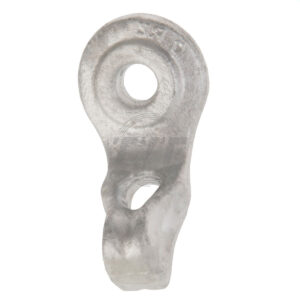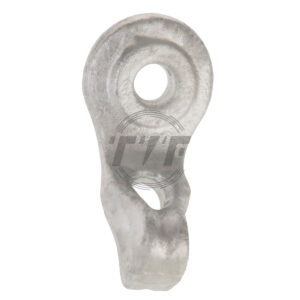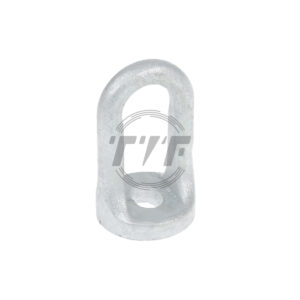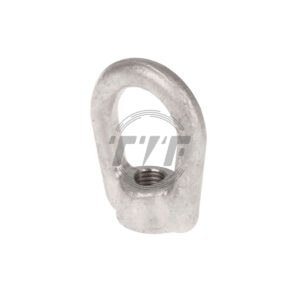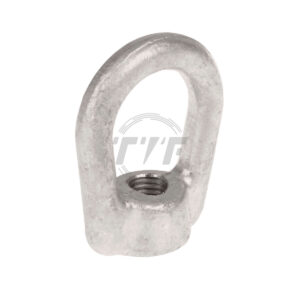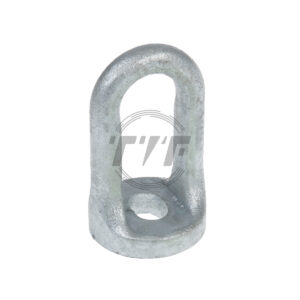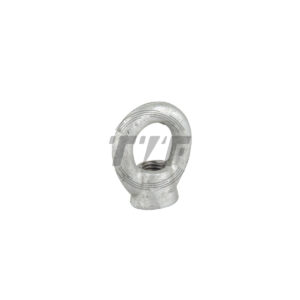Eyenut & Eyelet
The Eyenut /Eyelet is a type of utility fasteners. They are offered with oval, thimble and twin eyes for connecting under the head to the threaded end of bolts. All sizes are avaliable.
Showing all 8 results
-
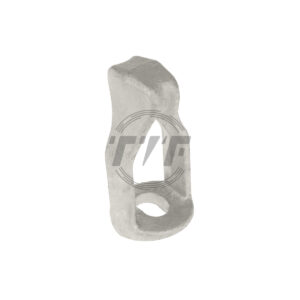
Eyelet
-

Eyelet, Angle for 45 Degrees, 5/8in
-

Galvanized Steel Eyelet
-

Galvanized Steel Eyelet, 1.2 lb
-

Galvanized Steel Eyenut, Tensile Strength 20,050 lb
-

Standard Eyenut for 3/4 in dia. Bolt, TSR 20,050 Lbs
-

Steel Eyelet, Weight: 1.1 lb
-

Steel Eyenut, Weight: 0.5 lb
Read More
This eye nut is intended exclusively for dead-ending and fastening pole head guys to cross arm bolts. Additionally, the eye nut may be used to back guy a power line.Eye nut for power line is available in a variety of styles. The thimble eye nut, the angle thimble eyelet, and the oval eye nut are general types of these. They are all applicable to any kind of power line. The eye nut is made of high-quality carbon steel. The huge strength of this material assures that the item will last a long time. Additionally, the eye nut is polished to prevent it from corrosion and physical damage caused by exposure to water and chemicals. Moreover, it is resistant to rust and other comparable detrimental substances. Our eye nut for power pole lines is available in a variety of designs. For example, a thimble eye nut may have either a twin or a triple eye. On the other side, the oval eye nut is threaded to accept 1/2″ or 5/8″ bolts that are passed vertically to connect to the dead end clamp. The threads on the thimble eye nut are identical to those on the bolts that connect insulators to the dead end wire. The eye nut has a basic yet applied design. This simplicity enables them to be easily installed and utilized. Internal threading and a looped head distinguish the eye nut. If you’re looking to purchase eye nuts for your power transmission line project, contact a reputable eye nut manufacturer in China. You will get further information, including the cost of the eye nut.Complete Buying Guide for Eye Nuts
When it comes to power and telecommunications projects, selecting the appropriate instrument for the job may make a significant difference in the project’s success or failure. This is critical since projects involving these two sectors are quite sensitive, particularly in terms of safety. Eye nuts are one example of such instruments. Your cables and connections will be carefully joined and secured with the correct eye nuts. Are you considering purchasing high-quality eye nuts in China? Be grateful that you have arrived at the correct location. I’m going to discuss all the key data about eye nuts in this essay.What is an Eye Nut?
To put it simply, eye nuts are fasteners with lopsided heads. They are intended to be used with hooks to fasten wires, cables, and even ropes. The eye nut head may be round or oval in form, depending on the application location. Typically, eye nuts are applied for vertical lifting. It is not recommended that they be used for angular lifting, since this may compromise their dependability and efficacy. However, certain non-load-rated eye nuts are utilized to secure cables or wires. These kind of eye nuts are not recommended for lifting applications.What Materials Are Used to Make Eye Nuts?
Different materials are used to make eye nuts. Each eye nut material has a distinct set of qualities that will ultimately effect the eye nuts’ function. Aluminium, stainless steel, alloy steel, and galvanized steel are the most often used materials for eye bolts. These metals’ characteristics are what make them the most popular materials for producing s eye nuts. To begin, the stainless steel is corrosion resistant. It comprises metals such as nickel, chromium, and molybdenum that help prevent the corrosion of the iron in the steel alloy. This implies that the eye nuts may be utilized in any location independent of the environmental variables that may cause rust. You may even use the eye nuts in a maritime environment without fear of rust or other external causes impairing their physical properties. Alloy steel eye nuts are typically ideal for usage in cold conditions. Because the lifting operation typically occurs at low temperatures, the eye nut will continue to function properly as necessary. Extreme temperature variations will have little effect on its structure. Both stainless steel and alloy steels maintain their metallurgical qualities over time. They keep their tensile strength in addition to being rust-proof. Galvanized steel is another material that is often used to manufacture eye bolts. This substance is essentially molten zinc-dipped steel. The zinc coating protects the eye bolt against corrosion, allowing it to be used outdoors. Overall, it is obvious that the material used to make eye nuts should be able to survive a variety of external circumstances. Additionally, it should be able to endure the physical force or load applied while usage. Although steel is the most often used material for eye nuts, brass eye nuts are not uncommon. While it is not as robust as steel, it is fully capable of performing its function.Eye Nuts Applications – Eye Nuts Uses
Eye nuts have a broad variety of uses. They are suitable for residential and industrial applications. The following is a list of the most frequently used uses for eye nuts. These fasteners are utilized in industrial settings to raise and tension wires. A excellent example would be power lines and telecommunications cables. At home, they serve as platforms for securing items to the wall. Eye nuts may also be tailored to fit any piece of machinery or equipment. The eye nuts’ superior structure is only one of the reasons for their extensive use. External variables such as weather conditions cannot readily impair their functioning. Additionally, the fact that these eye nuts are available in a variety of styles makes them suited for a variety of applications. You just simply to advise the lifting bolt maker of the location of the nuts, and they will modify them for you.How are Eye Nuts Constructed?
Fabrication Techniques
The ultimate form of eye nuts is determined by two crucial stages. These are the processes of forging and bending. After completing these two steps, you will have a solid piece of rod in the form of an eye nut. Typically, forged eye nuts are hammered or even pressed to alter their grain structures. As a consequence, a robust and durable eye nut capable of withstanding external stresses is created. Forged eye nuts are an excellent alternative for situations requiring strong lifting. They have a high tensile strength and are thus capable of withstanding such pressures. Additionally, this technique produces enormous eye nuts. On the other hand, bent eye nuts are created by physically bending a piece of steel rod into the shape of an eye. Bent eye nuts are recommended for use in lightweight applications. They are incapable of lifting substantial weights. Additionally, they are not appropriate for angular lifting.Eye Nuts Classification
Classified and Unclassified Eye Nuts Although there are several classification schemes for eye nuts, the most fundamental is by load rating. This categorization criteria is based on the fact that steel eye nuts are used. Load-rated eye nuts are designed specifically for vertical lifting. Using these eye nuts for angular lifting is not recommended. On the other hand, unrated eye nuts are not suited for lifting applications. Rather than that, they must be used in conjunction with the guiding wires or tie-downs.Eye Nuts with Complete Threading vs. Eye Nuts with Partial Threading
Another method to classify various varieties of eye nuts is by their threads. A threaded eye nut for sale might be completely or partly threaded. What separates these two forms of eye nuts? Fully threaded nuts are those that have the whole eye threaded from top to bottom. The term “partially threaded” refers to areas of the eye that are not threaded properly. Given the structure of the threads, it is critical to understand that the two kinds of eye nuts serve distinct functions. With a completely threaded nut, the tension applied to it is distributed throughout the structure. It is not only focused on a single point. This implies that these eye nuts can bear a greater amount of stress than partly threaded nuts. Additionally, properly threaded eye nuts rarely shear. Additionally, they seldom become too loose when exposed to external pressures capable of causing vibrations. On the other hand, partly threaded eye nuts are utilized in applications where shear resistance and durability are essential. Due to the lack of threads, the nut will have good shear characteristics. If you’re unsure which eye nut to choose, visit eye nut specialists or directly contact eye nut manufacturers for assistance.Characteristics of Eye Nuts
The Eye Nuts’ Maximum Load Capacity Each eye nut is rated for a maximum load. This is the maximum load weight that the eye nut can support. Never overload an eye nut’s load capacity, since this might cause it to fail or even malfunction. The load capacity of nut eyes varies depending on the material used. Certain materials have a greater load capacity than others.Thread Sizes for Eye Nuts
Eye nuts have thread diameters specified in inches and millimeters. 1/4, 3/8, 5/16, 7/12, 1/2, 7/8, 3/4, 1, 11/8, 11/4, 13/4, 2, 21/4, 21/2 are the most frequently used thread sizes. Typically, these thread sizes are marked as #16, #18, #20, and #24. M16, M18, M20, M24, M26, M30, M32, M36, M38, M40, M42, M54, M48, and M56 are the measures for the eye nuts. The M denotes the number of millimeters in the diameter of the eye nut in these measures. When purchasing eye nuts in China, pay close attention to the thread diameters. The incorrect thread size may be incompatible with your program.Specifications for Eye Nuts That You Should Be Aware Of
When purchasing eye nuts for sale, there are a few characteristics to consider. Here are a few examples.Diameter of the Bell
A bell is a component of an eye nut that houses the tap. These pieces are available in a variety of diameters. When purchasing this nut, you may specify that the diameter should be less than or equal to a certain value. It is entirely dependent on the application area.Threaded Length
This is the length of the tap’s threaded part. Again, the numbers may be set to either a minimum or a maximum value based on your needs.Inside Diameter/Width
This is the size of the eye nut’s bail. It works with both round and oval nuts.Dimension of the Eye Section
This is the thickness of the eye, which is also referred to as the bail of an eye.Weight
This term refers to the total weight of an eye nut. The majority of the time, the weight of an eye nut is dictated by the material used to create it.Installation and Maintenance of Eye Nuts
In the same manner that you used caution while selecting eye nuts, you should exercise the same prudence throughout installation and maintenance. Proper installation of the eye nuts ensures that they perform their tasks successfully. The following are some recommendations for installing and maintaining eye nuts:- Always clean the threads of the eye bolts before installing the nuts. This will guarantee correct attachment of the eye nut to the fastener.
- Always line the loads with the plane of the eye rather than with the angle. A steel washer may be used to achieve appropriate alignment.
- After applying the lift, inspect the seating of the eye nut. This is to assure the stability of the eye nut. If it is unstable, reseat and reinstall it until the necessary stability is achieved.
Precautions Regarding the Use of Eye Nuts
The following are some precautions to observe while working with eye nuts:- Avoid forcing a sling through the eye.
- Never tighten an eye nut excessively
- Avoid forcing hooks and other fittings into eye nuts. The link should be made without restriction.
- Do not exceed the eye nut’s rated capacity.
- Never use an eye nut that exhibits symptoms of wear.
- Always shock-hold an eye nut. Rather than that, raise gently.
- Do not attempt to alter an eye nut’s physical qualities by grinding or any other way.
- Avoid painting or coating the eye nuts. The majority of paints make it impossible to evaluate the condition of the eye nut and discover any problems.
Choosing a Chinese Manufacturer of Eye Nuts
Are you looking for a high-quality and reasonably priced eye nut for your project? The most secure method is to purchase from China’s inexpensive eye nut manufacturers and suppliers. This way, you’ll get the most best deals.TTF is a manufacturer of high-quality eye nuts in China. Our eye nuts are ideal for power lines and telecommunications applications.Along with common sizes of eye nuts, we can also provide you with specialized eye nuts to meet your project. You may also purchase eye nuts online using our site. Regardless of your location, contact us and make your purchase.

